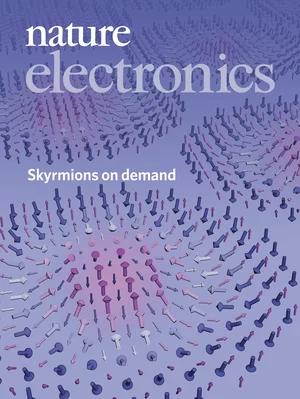In the quest for higher density information storage, some scientists have turned their attention to magnetic Skyrmions—stable nanometer-size swirls of spin. Initially restricted to liquid Helium temperatures, high applied magnetic fields, and to single-crystalline materials, magnetic Skyrmions are now routinely studied in various magnetic multilayer superlattices at room temperature and low applied magnetic fields. Researchers can generate and eliminate Skyrmions en-masse through the application of magnetic fields. However, the applicability of magnetic Skyrmions in future memory devices relies on the addressing and manipulation of single magnetic whirls.
Now, for the first time, researchers in a collaboration between the Korea Institute of Technology and other partners, among which the Paul Scherrer Institut (at the PolLux endstation of the Swiss Light Source) have created and then deleted isolated magnetic Skyrmions through the use of electrical current pulses. This achievement was obtained employing a multilayer superlattice stack with a Gadolinium-Iron-Cobalt ferrimagnetic alloy as the magnetic material. Perpendicular magnetic anisotropy, along with a non-vanishing Dzyalonshinsky-Moriya interaction was achieved by sandwiching the ferromagnetic layer between Platinum and Magnesium Oxide layers. The injection of an electrical current across the ferromagnetic superlattice stack generates, through the Spin Hall effect, spin torques that allow the generation and deletion of isolated magnetic Skyrmions.
The writing and deleting process was imaged by time-resolved scanning transmission x-ray microscopy in the pump-probe regime.
Contact
Dr. Seonghoon WooCenter for Spintronics
Korea Institute of Science and Technology
5, Hwarang-ro 14-gil
Seongbuk-gu, Seoul 02792, Republic of Korea
E-Mail: shwoo_@kist.re.kr
Phone: +82 2 958 6873
Original Publication
Deterministic creation and deletion of a single magnetic skyrmion observed by direct time-resolved X-ray microscopyS. Woo, K.M. Song, X. Zhang, M. Ezawa, Y. Zhou, X. Liu, M. Weigand, S. Finizio, J. Raabe, M.-C. Park, K.-Y. Lee, J. W. Choi, B.-C. Min, H. C. Koo, and J. Chang
Nat. Electr. 1, 288 (2018)
DOI: 10.1038/s41928-018-0070-8
